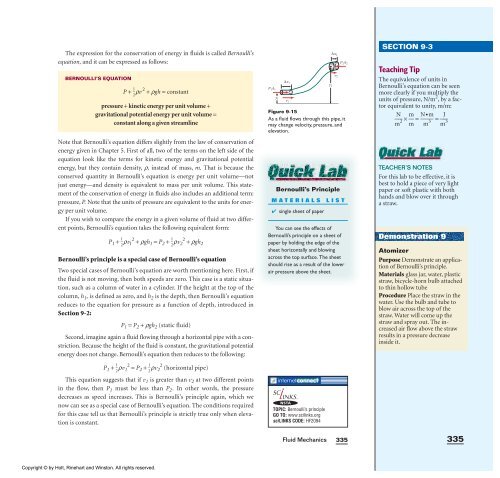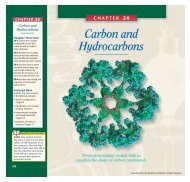You also want an ePaper? Increase the reach of your titles
YUMPU automatically turns print PDFs into web optimized ePapers that Google loves.
The expression for the conservation of energy in fluids is called Bernoulli’s<br />
equation, and it can be expressed as follows:<br />
BERNOULLI’S EQUATION<br />
P + ⎯ 1<br />
2 ⎯rv 2 + rgh = constant<br />
pressure + kinetic energy per unit volume +<br />
gravitational potential energy per unit volume =<br />
constant along a given streamline<br />
Note that Bernoulli’s equation differs slightly from the law of conservation of<br />
energy given in Chapter 5. First of all, two of the terms on the left side of the<br />
equation look like the terms for kinetic energy and gravitational potential<br />
energy, but they contain density, r, instead of mass, m. That is because the<br />
conserved quantity in Bernoulli’s equation is energy per unit volume—not<br />
just energy—and density is equivalent to mass per unit volume. This statement<br />
of the conservation of energy in fluids also includes an additional term:<br />
pressure, P. Note that the units of pressure are equivalent to the units for energy<br />
per unit volume.<br />
If you wish to compare the energy in a given volume of fluid at two different<br />
points, Bernoulli’s equation takes the following equivalent form:<br />
P 1 + ⎯ 1<br />
2 ⎯rv 1 2 + rgh1 = P 2 + ⎯ 1<br />
2 ⎯rv 2 2 + rgh2<br />
Bernoulli’s principle is a special case of Bernoulli’s equation<br />
Two special cases of Bernoulli’s equation are worth mentioning here. First, if<br />
the fluid is not moving, then both speeds are zero. This case is a static situation,<br />
such as a column of water in a cylinder. If the height at the top of the<br />
column, h 1, is defined as zero, and h 2 is the depth, then Bernoulli’s equation<br />
reduces to the equation for pressure as a function of depth, introduced in<br />
Section 9-2:<br />
P 1 = P 2 + rgh 2 (static fluid)<br />
Second, imagine again a fluid flowing through a horizontal pipe <strong>with</strong> a constriction.<br />
Because the height of the fluid is constant, the gravitational potential<br />
energy does not change. Bernoulli’s equation then reduces to the following:<br />
P 1 + ⎯ 1<br />
2 ⎯rv 1 2 = P2 + ⎯ 1<br />
2 ⎯rv 2 2 (horizontal pipe)<br />
This equation suggests that if v 1 is greater than v 2 at two different points<br />
in the flow, then P 1 must be less than P 2. In other words, the pressure<br />
decreases as speed increases. This is Bernoulli’s principle again, which we<br />
now can see as a special case of Bernoulli’s equation. The conditions required<br />
for this case tell us that Bernoulli’s principle is strictly true only when elevation<br />
is constant.<br />
Copyright © by Holt, Rinehart and Winston. All rights reserved.<br />
P1A1<br />
y1<br />
∆x 1<br />
v1<br />
Bernoulli’s Principle<br />
MATERIALS LIST<br />
✔ single sheet of paper<br />
You can see the effects of<br />
Bernoulli’s principle on a sheet of<br />
paper by holding the edge of the<br />
sheet horizontally and blowing<br />
across the top surface. The sheet<br />
should rise as a result of the lower<br />
air pressure above the sheet.<br />
NSTA<br />
TOPIC: Bernoulli’s principle<br />
GO TO: www.scilinks.org<br />
sciLINKS CODE: HF2094<br />
y2<br />
∆x2<br />
v2<br />
P 2A 2<br />
Figure 9-15<br />
As a fluid flows through this pipe, it<br />
may change velocity, pressure, and<br />
elevation.<br />
SECTION 9-3<br />
Teaching Tip<br />
The equivalence of units in<br />
Bernoulli’s equation can be seen<br />
more clearly if you multiply the<br />
units of pressure, N/m 2 , by a factor<br />
equivalent to unity, m/m:<br />
N<br />
⎯<br />
m<br />
2⎯ × ⎯ m<br />
m ⎯ = = ⎯ N •m J<br />
⎯m 3<br />
m<br />
3⎯<br />
TEACHER’S NOTES<br />
For this lab to be effective, it is<br />
best to hold a piece of very light<br />
paper or soft plastic <strong>with</strong> both<br />
hands and blow over it through<br />
a straw.<br />
Demonstration 9<br />
Atomizer<br />
Purpose Demonstrate an application<br />
of Bernoulli’s principle.<br />
Materials glass jar, water, plastic<br />
straw, bicycle-horn bulb attached<br />
to thin hollow tube<br />
Procedure Place the straw in the<br />
water. Use the bulb and tube to<br />
blow air across the top of the<br />
straw. Water will come up the<br />
straw and spray out. The increased<br />
air flow above the straw<br />
results in a pressure decrease<br />
inside it.<br />
<strong>Fluid</strong> <strong>Mechanics</strong> 335<br />
335
















